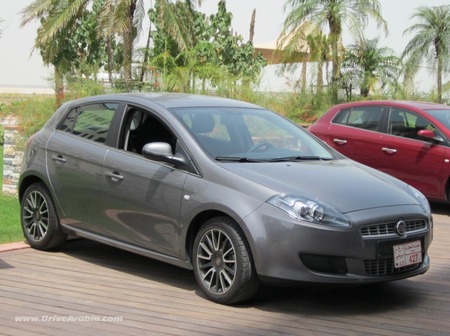First drive: 2010 Fiat Bravo in Abu Dhabi

Few companies offer media drives of their all-new models in the UAE itself before they become available to consumers. And we don’t get invited to most of them because they are afraid of us. However, Fiat is making a comeback in the region, and they did invite us to their 2010 Bravo unveiling in Abu Dhabi, complete with a fleet of European-spec test cars for the event.
We set out from the Radisson Blu hotel on Yas Island, not to drive on the track, but to take a round of Abu Dhabi city, along the Corniche road and back. The car itself is an attractive interpretation of the traditional hatchback profile, certainly much better than the awful VW Golf, but less aggressive than the Peugeot 308. I picked the graphite-coloured one, simply because it had the coolest rims.

Cabin space is about average for this class, on par with its European rivals. What sets it apart is extensive use of unique materials. While all rather firm, the rubbery door and dash materials feel premium to the touch, so we kept feeling them up like perverts. The seats and door inserts are fully customisable, and can be had with funky leather shapes or colour-changing cloth tones. The upholstery needs to be seen in person to be believed.

Storage spaces are limited, with small slots for mobile phones and coins here and there, along with an under-armrest chiller for one small bottle, and two so-called cup-holders that threw off our water bottles as soon as the car moved. However, the glove-box is massive.
The car I drove had a single-zone a/c and a basic stereo, although dual-zone climate control and proper infotainment setups are optionally available. Incidentally, a funny quirk of the Euro-spec cars were that the a/c compressor shuts off every time the car comes to a standstill. So we were sweating it out at red lights, but then when the car got moving, the a/c always blew ice-cold in less than 5 minutes. It is weird that Europeans choose fuel economy and emissions over comfort. However, Fiat spokespeople say the GCC-spec cars will not do this, so we expect the a/c to be excellent when the cars reach the showroom floor.
It is powered by a 120 hp 1.4-litre turbo, with 206 Nm of torque at only 1750 rpm, so initial kick is generally strong for city-driving, though there is a lag for a second when taking off. We clocked in around 10 litres/100 km in aggressive mixed-conditions driving.

The coolest part about this car would be confounding your friends with the “robotised” automanual gearbox, essentially a two-pedal manual transmission with a clutch and an automatic mode like in a Ferrari, instead of a regular torque-converter automatic like in every other car. The shifter only has options for Neutral, Reverse, Automatic and Manual with +/- modes, but not Park. The difference is that parking requires setting the handbrake up. Also, when idling, the car does not slowly roll forward in gear, like an automatic would. It took a while to figure out, but the only real issue is that some gear changes are clunky, just like in a Ferrari, which may not go well with drivers who crave “smoothness.” Manual shifting offers better control than the occasionally-confused automatic mode, and all gear-shifts are instantaneous.
The car itself has a decent suspension setup, offering as much comfort as can be expected from a compact hatchback. It tackles bumps at least as well as the top cars in this segment, while cabin noise suppression is on par for the class.
Another interesting feature on the Euro-spec cars was power steering. The steering feel is very firm in slow-speed driving, but can be made feather-light at the press of the “city” button. We simply left it in “city” mode, and it firmed up by itself once we hit the highway anyway. It is a rather unique take on variable power-steering systems.

Handling is about average, with a bit of controlled body roll and an intrusive stability control system. The rear seems to drift a bit on sharp zig-zag steering inputs, which could prove to be fun on a track, though the ESP can be distinctly felt. The turning circle is tight and the brakes are easy to modulate.
The Fiat Bravo is indeed an interesting addition to the fraternity of quirky European models that are affordable and appear to be more premium than they really are. Priced to compete with suddenly-expensive Japanese cars, Fiat may have a better chance at gaining market share than it did more than half-a-decade ago, when they left the GCC.
For UAE prices and GCC specs, visit the Fiat Bravo buyer guide.













Comments
Anil
i like!! but its priced quite high
ROJ
Isnt that the case in in today’s cars… These are the standard you’re paying for a compact car these days… I personally will stick to buying used for the mean time..
Zao
any news about fiat 500 abarth comming to this market?
ROJ
^ good question…
Mashfique Hussain Chowdhury
it will come. just no dates.
Roshan Gomez
the transmission sounds very similar to the seles speed in the Alfa 147, ya they are the same family…
auto
there is much better version of bravo, 150hp with manual transmission , any idea if we will see that model in GCC?